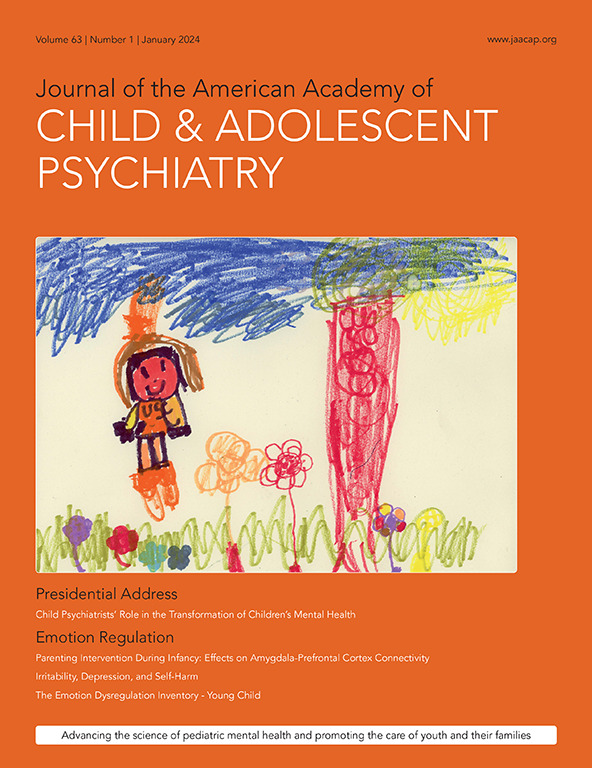西他那定治疗青少年注意力缺陷/多动障碍:一项随机临床试验。
IF 9.2
1区 医学
Q1 PEDIATRICS
Journal of the American Academy of Child and Adolescent Psychiatry
Pub Date : 2025-07-03
DOI:10.1016/j.jaac.2025.06.023
引用次数: 0
摘要
目的:这项随机、双盲、安慰剂对照试验评估了centanafadine(一种去甲肾上腺素、多巴胺、5 -羟色胺再摄取抑制剂)治疗青少年注意力缺陷/多动障碍(ADHD)的有效性、安全性和耐受性。方法初步诊断为ADHD的青少年(13-17岁,含)随机分为每日一次的centanafadine 164.4 mg、328.8 mg或安慰剂组,持续6周。没有滴定给药。主要终点是第6周ADHD评定量表第5版(ADHD- rs -5)症状总原始评分较基线的变化。该试验已在ClinicalTrials.gov注册(NCT05257265)。结果459例受试者(centanafadine 164.4 mg, n=155;328.8 mg, n=155;安慰剂,n=149), 451人接受了≥1剂量的研究药物,371人(80.8%)完成了试验。在第6周,服用328.8 mg的centanafadine组ADHD-RS-5症状总原始评分的改善显著高于安慰剂组(-18.50 [0.93]vs -14.15 [0.93];p = 0.0006);Centanafadine 164.4 mg没有达到主要终点。Centanafadine 328.8 mg在第1周(基线后的第一个时间点)显示与安慰剂分离,并在整个研究中保持效果。治疗出现的不良事件(teae)发生在48/153 (31.4%,164.4 mg)、76/151 (50.3%,328.8 mg)和35/147(23.8%,安慰剂)参与者中。最常见的teae(≥5%)是食欲下降、恶心、头痛和皮疹。大多数teae的严重程度为轻度或中度;重度3例:肝功能增高(n=1, 164.4 mg);攻击性(n= 1,164.4 mg);嗜睡(n=1,安慰剂组)。结论头孢那非定328.8 mg治疗青少年ADHD有效。两种剂量通常都是安全且耐受性良好的。本文章由计算机程序翻译,如有差异,请以英文原文为准。
Centanafadine for Attention-Deficit/Hyperactivity Disorder in Adolescents: A Randomized Clinical Trial.
OBJECTIVE
This randomized, double-blind, placebo-controlled trial evaluated the efficacy, safety, and tolerability of centanafadine-a norepinephrine, dopamine, serotonin reuptake inhibitor-in the treatment of attention-deficit/hyperactivity disorder (ADHD) in adolescents.
METHOD
Adolescents (ages 13-17 years, inclusive) with a primary diagnosis of ADHD were randomized to once-daily centanafadine 164.4 mg, 328.8 mg, or placebo for 6 weeks. Dosing was not titrated. The primary endpoint was change from baseline in the ADHD Rating Scale, version 5 (ADHD-RS-5) symptoms total raw score at Week 6. This trial is registered with ClinicalTrials.gov (NCT05257265).
RESULTS
Of 459 participants (centanafadine 164.4 mg, n=155; 328.8 mg, n=155; placebo, n=149), 451 received ≥1 dose of study drug and 371 (80.8%) completed the trial. At Week 6, improvements in ADHD-RS-5 symptoms total raw score were significantly greater with centanafadine 328.8 mg than with placebo (-18.50 [0.93] vs -14.15 [0.93]; p=0.0006); centanafadine 164.4 mg did not meet the primary endpoint. Centanafadine 328.8 mg showed separation from placebo at Week 1, the first post-baseline timepoint, with the effect maintained throughout the study. Treatment-emergent adverse events (TEAEs) occurred in 48/153 (31.4%, 164.4 mg), 76/151 (50.3%, 328.8 mg), and 35/147 (23.8%, placebo) participants. The most common (≥5% any group) TEAEs were decreased appetite, nausea, headache, and rash. Most TEAEs were of mild or moderate severity; 3 events were severe: liver function test increased (n=1, 164.4 mg); aggression (n=1, 164.4 mg); and somnolence (n=1, placebo).
CONCLUSION
Centanafadine 328.8 mg was efficacious for ADHD treatment in adolescents. Both doses were generally safe and well tolerated.
求助全文
通过发布文献求助,成功后即可免费获取论文全文。
去求助
来源期刊
CiteScore
21.00
自引率
1.50%
发文量
1383
审稿时长
53 days
期刊介绍:
The Journal of the American Academy of Child & Adolescent Psychiatry (JAACAP) is dedicated to advancing the field of child and adolescent psychiatry through the publication of original research and papers of theoretical, scientific, and clinical significance. Our primary focus is on the mental health of children, adolescents, and families.
We welcome unpublished manuscripts that explore various perspectives, ranging from genetic, epidemiological, neurobiological, and psychopathological research, to cognitive, behavioral, psychodynamic, and other psychotherapeutic investigations. We also encourage submissions that delve into parent-child, interpersonal, and family research, as well as clinical and empirical studies conducted in inpatient, outpatient, consultation-liaison, and school-based settings.
In addition to publishing research, we aim to promote the well-being of children and families by featuring scholarly papers on topics such as health policy, legislation, advocacy, culture, society, and service provision in relation to mental health.
At JAACAP, we strive to foster collaboration and dialogue among researchers, clinicians, and policy-makers in order to enhance our understanding and approach to child and adolescent mental health.

 求助内容:
求助内容: 应助结果提醒方式:
应助结果提醒方式:


